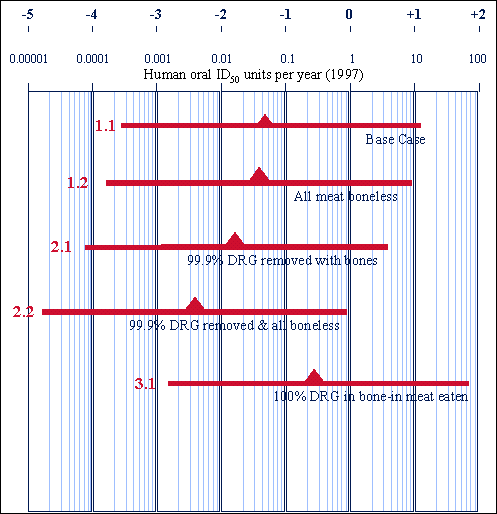
| Philip J Comer | December 8, 1997 |
This is an addendum to Revision 1 of the DNV report “Assessment of Risk from Possible BSE Infectivity in Dorsal Root Ganglia”, dated 6th December 1997. In that report, it was estimated that about 24% of the calculated risk of total infectivity derived from bone-in meat. It also shows that with current UK practices of carcase dressing, only 5% of the meat adjacent to the vertebral column reaches the consumer still attached to the vertebral column.
The purpose of this addendum is to investigate the sensitivity of the results to some of the assumptions relevant to the proposal to remove all bone from meat. This note deals only with issues relating to dorsal root ganglia (DRG), and not to any infectivity that there may be in the bone marrow of older animals with clinical symptoms of BSE.
Results have been calculated for 5 new cases using the same assumptions in the Monte Carlo simulation for all variables apart from those noted. The cases are in three pairs, with each one showing the effect of a change in one main assumption, and then combining this with the effect of removing all meat from the bone. The results are shown together with the base case in Table 1. The results for the Total Infectivity consumed by the UK population in 1997 are also plotted on a log scale in Figure 1. This shows the median and the 95 percentile range of the results. The cases are:
| 1.1 | Base Case: all data as for Revision 1. |
| 1.2 | As base case, but with 100% of meat sold off the bone. |
| 2.1 | As base case, but with 99.9% of the DRG removed with the bone for boneless meat rather than 99%. |
| 2.2 | Case 2.1 with 100% of meat sold off the bone. |
| 3.1 | As base case, but with 100% of the DRG in bone-in meat eaten rather than 5%. |
| 3.2 | Case 3.1 with 100% of meat sold off the bone. Not calculated, as this will be the same as 1.2. |
| Case | Total Infectivity ID50units in 1997 |
Individual Risk ID50units per person/yr |
% due to bone-in |
||
| Median | 95% range | Median | 95% range | ||
| 1.1 Base Case | .047 | 2.10-4 - 12 | 9.10-10 | 5.10-12 - 2.10-7 | 23% |
| 1.2 100% of meat boneless | .038 | 2.10-4 - 9 | 7.10-10 | 4.10-12 - 2.10-7 | 0% |
| 2.1 99.9% of DRG removed with bones | .014 | 8.10-5 - 4 | 3.10-10 | 2.10-12 - 7.10-8 | 75% |
| 2.2 2.1 with 100% of meat boneless | .004 | 2.10-5 - 0.9 | 7. 10-11 | 4.10-13 - 2.10-8 | 0% |
| 3.1 100% DRG eaten with bone-in meat | .25 | 1.3.10-3 - 63 | 5. 10-9 | 3.10-11 - 1.10-6 | 86% |
Comparison of Case 1.2 with the Base Case shows that, with the base set of assumptions, the proposal to remove all meat from the bone would only reduce the median total infectivity consumed by the UK population from 0.047 to 0.038 ID50 units in 1997, a reduction of 19%. From Figure 1 it can be seen that with the range of uncertainty in the results this is a negligible reduction.
If 99.9% of the DRG are removed with the bone in boning out plants (Case 2.1.), then it can be seen that the overall risks are reduced by about a factor of 3. However, as shown by Figure 1, this does not really alter the risk profile. One significant difference is that now about 75% of the infectivity consumed is from bone-in meat. Now, adding 100% boneless meat makes a bigger reduction. The median total infectivity for Case 2.2 is reduced to 0.004 ID50 units in 1997, which is a 73% reduction from Case 2.1. However, the absolute reduction of 0.01 ID50 units remains the same. From Figure 1 it can be seen that the upper value for the 95% range has been reduced to just below 1 ID50 unit.
Case 3.1 has been included to give an upper estimate on the base case, reflecting uncertainty in the proportion of DRGs eaten from bone-in meat. Although the DRG is relatively unlikely to be consumed directly, if the bone was subsequently used to make stock this could result in most of the DRG going into the food chain. This would increase the overall risk by about a factor of 5, and give a high proportion of the infectivity from bone-in meat. Taking all meat off the bone would reduce this risk by 85%.

The base results indicated that removing all meat from the bone would have little effect on the total infectivity consumed due to DRG. However, this sensitivity assessment has shown that this conclusion is very dependent on the assumptions made in the assessment. If more DRG are removed with the bone than was originally assumed, then taking meat off the bone becomes more effective. This is also true if more infectivity is consumed from DRG in bone-in meat, for example due to making stock.